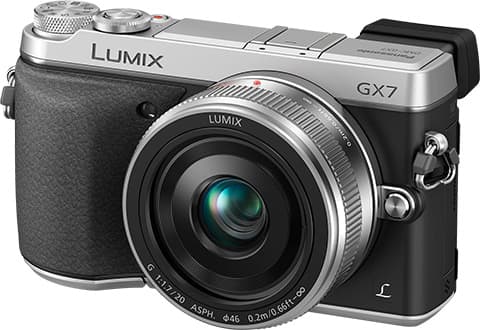The GX7 will cost £819, body-only, when it goes on sale in September.
[Article updated at 10am to include new ‘Leica’ 42.5mm f/1.2 lens]
The 16-million-pixel camera features what Panasonic claims is the world’s first built-in, tiltable, 90° live viewfinder on a digital single-lens mirrorless body. It boasts a resolution of more than 2.7-million dots and is designed to allow the user to achieve ‘the perfect shot from any angle’.
The GX7 also sports a 3in, 1.04-million-dot resolution, tiltable LCD touch screen in a body designed to weigh 402g.
Billed as the first Lumix to incorporate in-body image stabilisation, the GX7 can be tailored for use with old, non-stabilised, lenses, by the user entering a focal length from 8mm-1,000mm.
The camera will automatically detect if the attached lens already includes Lumix OIS, adds Panasonic.
‘Low noise’
Meanwhile, Panasonic claims that the ‘low noise’ imaging sensor delivers a significant improvement in low-light shooting compared to its predecessor, the now-discontinued Lumix DMC-GX1.
The GX7 offers better ISO sensitivity (up to ISO 25,600) and improved dynamic range.
In a statement the firm said: ‘The GX7 sensor achieves a higher saturation of light than other Lumix models due to its optimised pixel architecture – with reduced circuitry and expanded light receiving area…
‘In addition, the microlenses are optimised, enabling the sensor to take in more light.’
AP Editor Damien Demolder, who has seen the camera, said: ‘It is very interesting how close this camera is to the look of a traditional rangefinder, with it’s “Leica M9 with a grip” design.
‘It seems Panasonic is aiming directly at the market that aspires to a Leica camera, but which finds the price too painful.
‘There is a large number of photographers who are prepared to spend close to £1,000 on a high quality camera of the kind they’ll use at least once a week, and Panasonic says this is who the GX7 model is aimed at.’

The GX7 employs a 23-area focusing system with pinpoint AF, touch AF, and AF tracking.
Precision focusing should be helped by the inclusion of a 3x-10x enlargement function (in 0.1x gradients).
The GX7 is claimed to be able to focus in low light, down to -4EV – allowing shooting ‘under starlight’ – and focus as fast as 0.06sec, using Light Speed AF.
In a nod to the past, the camera aims to double as a darkroom by enabling the photographer to alter the contrast on b&w shots, using Monochrome, Rough Monochrome and Silky Monochrome filters. The effect of each can be adjusted in strength, in-camera. Colour filters can also be applied to monochrome images.
New to Lumix is the display of a graduation curve that can be used to fine-tune contrast. ‘Highlights and shadows are adjusted via the touchscreen or front and rear dials allowing you to create your own unique look…’
These, in turn, can be stored in the custom setting or presets.
Features also include a top shutter speed of 1/8000sec, a burst rate of five frames per second at full resolution and a ‘silent shutter mode’.
The GX7 user can transfer their shots to a smartphone or tablet using Near Field Communication. This wireless technology also enables external devices to control the camera.
Housed in a magnesium-alloy frame, the GX7 will be available in black and silver-coloured versions.
A kit that includes a 20mm lens will cost £999. A 14-42mm outfit is priced at £899.
AP aims to publish a full review in a late September/early October issue
• Panasonic has also today announced it is working on the development of a Leica-branded DG Nocticron 42.5mm f/1.2 lens. It has not yet revealed a launch date, specification or expected price.







